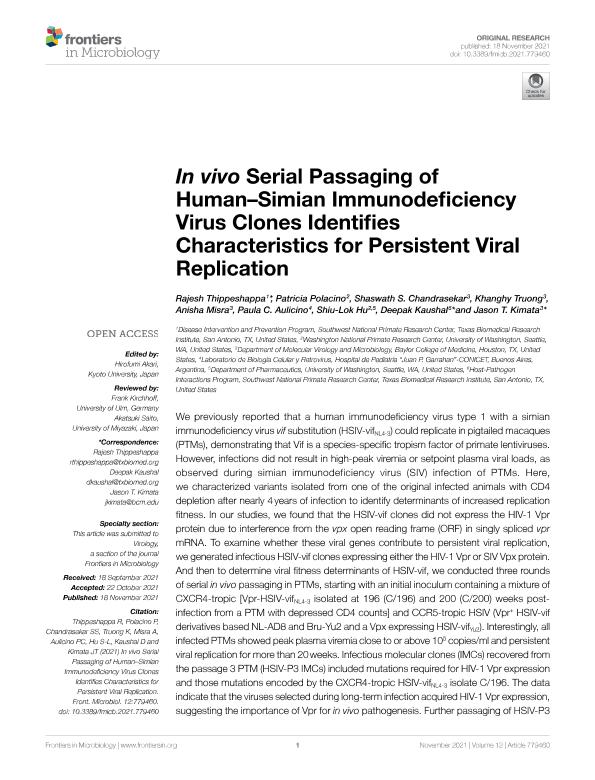Artículo
In vivo serial passaging of human–simian immunodeficiency virus clones identifies characteristics for persistent viral replication
Thippeshappa, Rajesh; Polacino, Patricia; Chandrasekar, Shaswath S.; Truong, Khanghy; Misra, Anisha; Aulicino, Paula ; Hu, Shiu-Lok; Kaushal, Deepak; Kimata, Jason T.
; Hu, Shiu-Lok; Kaushal, Deepak; Kimata, Jason T.
 ; Hu, Shiu-Lok; Kaushal, Deepak; Kimata, Jason T.
; Hu, Shiu-Lok; Kaushal, Deepak; Kimata, Jason T.
Fecha de publicación:
11/2021
Editorial:
Frontiers Media
Revista:
Frontiers in Microbiology
ISSN:
1664-302X
Idioma:
Inglés
Tipo de recurso:
Artículo publicado
Clasificación temática:
Resumen
We previously reported that a human immunodeficiency virus type 1 with a simian immunodeficiency virus vif substitution (HSIV-vifNL4-3) could replicate in pigtailed macaques (PTMs), demonstrating that Vif is a species-specific tropism factor of primate lentiviruses. However, infections did not result in high-peak viremia or setpoint plasma viral loads, as observed during simian immunodeficiency virus (SIV) infection of PTMs. Here, we characterized variants isolated from one of the original infected animals with CD4 depletion after nearly 4years of infection to identify determinants of increased replication fitness. In our studies, we found that the HSIV-vif clones did not express the HIV-1 Vpr protein due to interference from the vpx open reading frame (ORF) in singly spliced vpr mRNA. To examine whether these viral genes contribute to persistent viral replication, we generated infectious HSIV-vif clones expressing either the HIV-1 Vpr or SIV Vpx protein. And then to determine viral fitness determinants of HSIV-vif, we conducted three rounds of serial in vivo passaging in PTMs, starting with an initial inoculum containing a mixture of CXCR4-tropic [Vpr-HSIV-vifNL4-3 isolated at 196 (C/196) and 200 (C/200) weeks post-infection from a PTM with depressed CD4 counts] and CCR5-tropic HSIV (Vpr+ HSIV-vif derivatives based NL-AD8 and Bru-Yu2 and a Vpx expressing HSIV-vifYu2). Interestingly, all infected PTMs showed peak plasma viremia close to or above 105 copies/ml and persistent viral replication for more than 20weeks. Infectious molecular clones (IMCs) recovered from the passage 3 PTM (HSIV-P3 IMCs) included mutations required for HIV-1 Vpr expression and those mutations encoded by the CXCR4-tropic HSIV-vifNL4-3 isolate C/196. The data indicate that the viruses selected during long-term infection acquired HIV-1 Vpr expression, suggesting the importance of Vpr for in vivo pathogenesis. Further passaging of HSIV-P3 IMCs in vivo may generate pathogenic variants with higher replication capacity, which will be a valuable resource as challenge virus in vaccine and cure studies.
Archivos asociados
Licencia
Identificadores
Colecciones
Articulos(SEDE CENTRAL)
Articulos de SEDE CENTRAL
Articulos de SEDE CENTRAL
Citación
Thippeshappa, Rajesh; Polacino, Patricia; Chandrasekar, Shaswath S.; Truong, Khanghy; Misra, Anisha; et al.; In vivo serial passaging of human–simian immunodeficiency virus clones identifies characteristics for persistent viral replication; Frontiers Media; Frontiers in Microbiology; 12; 11-2021; 1-14
Compartir
Altmétricas



